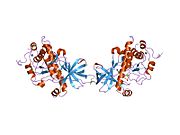Transient receptor potential channels are a group of ion channels located mostly on the plasma membrane of numerous animal cell types. Most of these are grouped into two broad groups: Group 1 includes TRPC, TRPV, TRPVL, TRPM, TRPS, TRPN, and TRPA. Group 2 consists of TRPP and TRPML. Other less-well categorized TRP channels exist, including yeast channels and a number of Group 1 and Group 2 channels present in non-animals. Many of these channels mediate a variety of sensations such as pain, temperature, different kinds of taste, pressure, and vision. In the body, some TRP channels are thought to behave like microscopic thermometers and used in animals to sense hot or cold. Some TRP channels are activated by molecules found in spices like garlic (allicin), chili pepper (capsaicin), wasabi ; others are activated by menthol, camphor, peppermint, and cooling agents; yet others are activated by molecules found in cannabis or stevia. Some act as sensors of osmotic pressure, volume, stretch, and vibration. Most of the channels are activated or inhibited by signaling lipids and contribute to a family of lipid-gated ion channels.
Magnesium deficiency is an electrolyte disturbance in which there is a low level of magnesium in the body. Symptoms include tremor, poor coordination, muscle spasms, loss of appetite, personality changes, and nystagmus. Complications may include seizures or cardiac arrest such as from torsade de pointes. Those with low magnesium often have low potassium.

TRPV6 is a membrane calcium (Ca2+) channel protein which is particularly involved in the first step in Ca2+absorption in the intestine.
TRPC is a family of transient receptor potential cation channels in animals.
TRPM is a family of transient receptor potential ion channels (M standing for wikt:melastatin). Functional TRPM channels are believed to form tetramers. The TRPM family consists of eight different channels, TRPM1–TRPM8.

Mucolipin-1(ML1) also known as TRPML1 is a protein that in humans is encoded by the MCOLN1 gene. It is a member of the small family of the TRPML channels, a subgroup of the large protein family of TRP ion channels.

TRPM6 is a transient receptor potential ion channel associated with hypomagnesemia with secondary hypocalcemia.

Transient receptor potential cation channel, subfamily C, member 6 or Transient receptor potential canonical 6, also known as TRPC6, is a protein encoded in the human by the TRPC6 gene. TRPC6 is a transient receptor potential channel of the classical TRPC subfamily.

Transient receptor potential canonical 1 (TRPC1) is a protein that in humans is encoded by the TRPC1 gene.

Short transient receptor potential channel 3 (TrpC3) also known as transient receptor protein 3 (TRP-3) is a protein that in humans is encoded by the TRPC3 gene. The TRPC3/6/7 subfamily are implicated in the regulation of vascular tone, cell growth, proliferation and pathological hypertrophy. These are diacylglycerol-sensitive cation channels known to regulate intracellular calcium via activation of the phospholipase C (PLC) pathway and/or by sensing Ca2+ store depletion. Together, their role in calcium homeostasis has made them potential therapeutic targets for a variety of central and peripheral pathologies.

The short transient receptor potential channel 4 (TrpC4), also known as Trp-related protein 4, is a protein that in humans is encoded by the TRPC4 gene.

Short transient receptor potential channel 5 (TrpC5) also known as transient receptor protein 5 (TRP-5) is a protein that in humans is encoded by the TRPC5 gene. TrpC5 is subtype of the TRPC family of mammalian transient receptor potential ion channels.

Transient receptor potential cation channel, subfamily M, member 2, also known as TRPM2, is a protein that in humans is encoded by the TRPM2 gene.

Transient receptor potential cation channel subfamily M member 5 (TRPM5), also known as long transient receptor potential channel 5 is a protein that in humans is encoded by the TRPM5 gene.

Transient receptor potential cation channel subfamily V member 2 is a protein that in humans is encoded by the TRPV2 gene. TRPV2 is a nonspecific cation channel that is a part of the TRP channel family. This channel allows the cell to communicate with its extracellular environment through the transfer of ions, and responds to noxious temperatures greater than 52 °C. It has a structure similar to that of potassium channels, and has similar functions throughout multiple species; recent research has also shown multiple interactions in the human body.

Transient receptor potential cation channel subfamily M member 4 (hTRPM4), also known as melastatin-4, is a protein that in humans is encoded by the TRPM4 gene.

Transient receptor potential cation channel subfamily M member 3 is a protein that in humans is encoded by the TRPM3 gene.

Transient receptor potential cation channel subfamily V member 5 is a calcium channel protein that in humans is encoded by the TRPV5 gene.

1-Phosphatidylinositol-4,5-bisphosphate phosphodiesterase beta-2 is an enzyme that in humans is encoded by the PLCB2 gene.

Mucolipin-2 also known as TRPML2 is a protein that in humans is encoded by the MCOLN2 gene. It is a member of the small family of the TRPML channels, a subgroup of the large protein family of TRP ion channels.



















